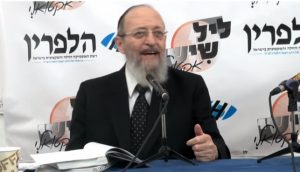Hechsher and Tevilas Keilim
“כל דבר אשר יבא באש תעבירו באש וטהר אך במי נדה יתחטא וכל אשר לא יבא באש תעבירו במים” (לא:כג)
Hechsher keilim is the alef-beis of a kosher kitchen. In addition to purging a used utensil bought from a Goy of its non-kosher blios, there is also the din of tevilas keilim which is learned from here. It is a machlokes Rishonim if tevilas keilim is a derasha gemurah d’Oraysah, or if it is an asmachta d’Rabbanan.
Regarding geirus, there are two steps (nowadays): milah and tevilah. That is the order the Gemara puts it in. There is a machlokes, though if the order is l’ikuvah. The Ramban holds that even if the tevilah was done before the milah, it still works. However, the Rashba holds that it doesn’t work. His reason is based on that which Chazal say, “Ha’poreish min ha’orlah k’poreish min ha’kever”.
For Jews, lack of bris milah does not effect the inherent kedushas Yisrael. There were communities in Europe that wanted to enact that children not given a bris milah would not be registered as Jews in the official communal archives. However, Reb Chaim (Brisker) said that you cannot do that. It is wrong. He is still a Yid.
When it comes to a Goy, though, the Rashba holds that the lack of bris milah is inherently contradictory to tevilah. For a ger, it’s not just a particular mitzvah. So long as he still has orlah, according to the Rashba, the tevilah cannot take effect.
Interestingly enough, the Ritva at the end of Maseches Avodah Zarah says that the same machlokes would apply to tevilas keilim. That, according to the shitah of the Rashba, being baluah with non-kosher taam makes it that tevilahcannot take effect on the kli.
The Ramban asks, why is it that this issue of hechsher keilim only arose now by milchemes Midyan? Why wasn’t it addressed by the conquest of Sichon and Og, wherein there was quite a lot of spoils of war?
The Gemara learns out from “batim m’lei’im kol tuv” that during war it is mutar to eat maachalos asuros. The Rambam holds that this is true regarding any war being waged within enemy territory (“gvul Akum”), but only if they don’t have kosher food available to eat. The Rambam puts this together with the din of yefas toar, that it is also a function of “lo dibrah Torah elah k’neged yeitzer hara”. The Rambam also includes yayin nesech in this heter.
The Ramban, though, argues on all three points. He holds that the heter is only regarding kibush Eretz Yisrael. It is even if they have kosher food; it is simply hutrah. It is not “dibrah Torah k’neged yeitzer hara”; it is heter gamur. Also, the heter does not apply to yayin nesech, since yayin nesech is not just non-kosher, but it also has a din of biur avodah zarah.
L’shitaso, the Ramban resolves his question. Eretz Sichon v’Og did not have to be conquered now; it could have waited until l’asid lavoh. However, inherently it is part of nachalas Eretz Yisrael. Therefore, once Sichon and Ogattacked, and it became necessary to conquer them and their land, it had a full-fledged din of kibush ha’Aretz. Therefore, the heter of eating non-kosher food applied. As such, there was no necessity to worry about blios either. However, milchemes Midyan had nothing to do with kibush Eretz Yisrael – it is chutz la’Aretz – and the heter did not apply there. That is why it was the very first time that they needed to deal with the dinim of hechsher keilim.
The Achronim ask on the Ramban, even though the heter of maachalos asuros applied in the war against Sichon and Og, why didn’t they have to be concerned for blios of yayin nesech, which the Ramban holds is not included in the heter?! Many answer – and it is a correct, lomdisheh teirutz – that the din of biur avodah zarah does not apply to taamwhich is baluah inside of keilim. It so happens, that the same thing is true regarding taam of chametz inside of keilim, that there is no din of tashbisu. The whole reason the heter of “m’lei’im kol tuv” does not apply to yayin nesech is because of the din of biur avodah zarah; so, regarding taam of yayin nesech inside of keilim, where there is no din of biur, the heter does apply.
There is yet another question that we can ask on this Ramban. Why didn’t the din of tevilas keilim apply by milchemes Sichon v’Og? Rav Yerucham Gorelick said over a teirutz in the name of Reb Chaim: the din of tevilas keilim is only when you bought it from the Goy, but by milchemes Sichon v’Og they were zocheh in the keilim from the cheirem. That is what Reb Chaim said, but I am not sure exactly what it means.
From Vayigdal Moshe, here.


 It is with great sadness that the first bit of news to reach me after Shavuos here in Yerushalayim was the petirah of R. Nosson Kamenetsky zt”l. While some will remember him for the controversy surrounding his two-volume Making of a Gadol, there are far more memorable images of him that history should retain.
It is with great sadness that the first bit of news to reach me after Shavuos here in Yerushalayim was the petirah of R. Nosson Kamenetsky zt”l. While some will remember him for the controversy surrounding his two-volume Making of a Gadol, there are far more memorable images of him that history should retain.